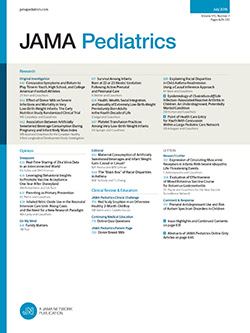EEG-Guided Titration of Sevoflurane and Pediatric Anesthesia Emergence Delirium
IF 24.7
1区 医学
Q1 PEDIATRICS
引用次数: 0
Abstract
ImportancePediatric anesthesia emergence delirium (PAED) is a common complication of general anesthesia and has unknown etiology. Exposure to volatile anesthetics may contribute to PAED, and excessive exposure may occur frequently during routine pediatric anesthesia.ObjectiveTo examine whether use of electroencephalography (EEG) monitoring can reduce PAED by minimizing exposure to sevoflurane while maintaining a state of unconsciousness under anesthesia.Design, Setting, and ParticipantsA single-center, parallel-group, 2-arm, superiority randomized clinical trial with a 1:1 allocation ratio was conducted from October 13, 2021, to March 18, 2023, at an academic tertiary pediatric hospital in Japan. The follow-up period was 24 ± 6 hours postoperatively or uneventful discharge to home, whichever came first. The observer for the primary outcome was blinded to patient assignment. The trial included a convenience sample of children aged 1 to younger than 6 years undergoing general anesthesia for procedures for which reliable antinociception can be provided. Data analysis was performed in March 2023.InterventionEEG-guided titration of anesthesia to minimize sevoflurane exposure (EEG-guided group) vs standard 1.0–minimum alveolar concentration (MAC) sevoflurane anesthesia (control group).Main Outcomes and MeasuresProportion of patients who developed PAED, defined by a maximum PAED score of 10 or higher.ResultsOf the 177 participants who completed follow-up, 125 (71%) were male and 52 (29%) were female. The EEG-guided group included 91 participants (mean [SD] age, 2.9 [1.5] years), and the control group included 86 participants (mean [SD] age, 2.8 [1.6] years). In the EEG-guided group, sevoflurane exposure was reduced by 1.4 MAC-hours (96.65% CI, 1.1 to 1.6 MAC-hours). A total of 30 (35%) in the control group and 19 (21%) in the EEG-guided group developed PAED (difference, 14%; 96.65% CI, −0.0019% to 28%; 95% CI, 0.92% to 27%;脑电图引导下的七氟醚滴定与小儿麻醉后谵妄
小儿麻醉突发性谵妄(PAED)是全麻常见并发症,病因不明。暴露于挥发性麻醉药可能导致PAED,在常规儿科麻醉中,过度暴露可能经常发生。目的探讨在麻醉状态下保持昏迷状态,同时尽量减少七氟醚的暴露,是否可以通过脑电图监测来减少PAED。设计、环境和参与者:2021年10月13日至2023年3月18日,在日本一家学术三级儿科医院进行了一项单中心、平行组、双臂、优势随机临床试验,分配比例为1:1。随访时间为术后24±6小时或顺利出院回家,以先到者为准。主要结局的观察者对患者分配不知情。该试验纳入了1至6岁以下儿童的方便样本,他们接受全身麻醉,可以提供可靠的抗避孕措施。数据分析于2023年3月进行。干预脑电图引导下的麻醉滴定以减少七氟醚暴露(脑电图引导组)与标准1.0 -最低肺泡浓度(MAC)七氟醚麻醉(对照组)。主要结局和测量发生PAED的患者比例,PAED的最大评分为10分或更高。结果在177名完成随访的参与者中,男性125人(71%),女性52人(29%)。脑电图引导组包括91名参与者(平均[SD]年龄,2.9[1.5]岁),对照组包括86名参与者(平均[SD]年龄,2.8[1.6]岁)。在脑电图引导组,七氟烷暴露减少了1.4 mac -小时(96.65% CI, 1.1 - 1.6 mac -小时)。对照组共30例(35%),脑电图引导组19例(21%)发生PAED(差异14%;96.65% CI,−0.0019% ~ 28%;95% CI, 0.92% ~ 27%;P = .04)。脑电图引导组儿童全麻时间平均提前21.4分钟(96.65% CI, 15.4 ~ 27.4分钟),麻醉后护理单元平均减少16.5分钟(96.65% CI, 10.8 ~ 22.3分钟)。结论及相关性脑电图引导的全麻管理减少了儿童七氟醚暴露和小儿麻醉出现谵妄,出现更快,麻醉后住院时间更短。研究结果表明,高浓度七氟醚诱导后常规使用1.0-MAC七氟醚维持可能过量。日本临床试验注册中心标识符:jRCTs032210248
本文章由计算机程序翻译,如有差异,请以英文原文为准。
求助全文
约1分钟内获得全文
求助全文
来源期刊

JAMA Pediatrics
PEDIATRICS-
CiteScore
31.60
自引率
1.90%
发文量
357
期刊介绍:
JAMA Pediatrics, the oldest continuously published pediatric journal in the US since 1911, is an international peer-reviewed publication and a part of the JAMA Network. Published weekly online and in 12 issues annually, it garners over 8.4 million article views and downloads yearly. All research articles become freely accessible online after 12 months without any author fees, and through the WHO's HINARI program, the online version is accessible to institutions in developing countries.
With a focus on advancing the health of infants, children, and adolescents, JAMA Pediatrics serves as a platform for discussing crucial issues and policies in child and adolescent health care. Leveraging the latest technology, it ensures timely access to information for its readers worldwide.
 求助内容:
求助内容: 应助结果提醒方式:
应助结果提醒方式:


